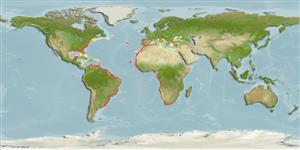Common names from other countries
Ελασμοβράγχιοι (καρχαρίες και σαλάχια) (sharks and rays) >
Myliobatiformes (Stingrays) >
Gymnuridae (Butterfly rays)
Etymology: Gymnura: Greek, gymnos = naked + Greek, oura = tail (Ref. 45335).
More on author: Linnaeus.
Environment: milieu / climate zone / depth range / distribution range
Οικολογία
Θαλασσινό(ά); Υφάλμυρο βενθικό(ς); εύρος βάθους 5 - 100 m (Ref. 6808). Subtropical; 47°N - 39°S, 98°W - 42°E
Western Atlantic: southern New England, USA, Brazil (Ref. 7251) to Argentina (Ref. 58839). Eastern Atlantic: Portugal to Ambriz, Angola (including the Mediterranean, Black Sea, and the Madeira and Canary islands).
Μέγεθος / Βάρος / Age
Maturity: Lm ? range ? - ? cm
Max length : 400 cm WD αρσενικό/απροσδιόριστο; (Ref. 3709); common length : 200 cm WD αρσενικό/απροσδιόριστο; (Ref. 3709); μεγ. δημοσιευμένο βάρος: 60.0 kg (Ref. 4699)
Tail short armed with spine. Disk very broad. Very low dorsal and ventral finfolds on tail (Ref. 7251). Disk dark brown to grayish, lower surface of disc and of pelvic fins white, brownish, rosy or rusty cast. Tail white or rosy white below (Ref. 6902).
Maximum length measured is 140 cm (Ref. 5377). Occurs over sand and mud. Feeds on fishes, crustaceans, mollusks and plankton. Ovoviviparous, gestation lasting about 6 months with 4 to 7 embryos produced per female (Ref. 6676).
Exhibit ovoviparity (aplacental viviparity), with embryos feeding initially on yolk, then receiving additional nourishment from the mother by indirect absorption of uterine fluid enriched with mucus, fat or protein through specialised structures (Ref. 50449). Distinct pairing with embrace (Ref. 205).
Bauchot, M.-L., 1987. Raies et autres batoides. p. 845-886. In W. Fischer, M.L. Bauchot and M. Schneider (eds.) Fiches FAO d'identificationpour les besoins de la pêche. (rev. 1). Mèditerranée et mer Noire. Zone de pêche 37. Vol. II. Commission des Communautés Européennes and FAO, Rome. (Ref. 3261)
IUCN Red List Status (Ref. 130435)
CITES (Ref. 128078)
Not Evaluated
Threat to humans
Harmless
Human uses
αλιεία: περιορισμένης εμπορικότητας; αλιεία αναψυχής: ναί
Εργαλεία
Special reports
Download XML
Διαδικτυακές πηγές
Estimates based on models
Preferred temperature (Ref.
115969): 14.9 - 27.8, mean 23.6 (based on 860 cells).
Phylogenetic diversity index (Ref.
82804): PD
50 = 0.5000 [Uniqueness, from 0.5 = low to 2.0 = high].
Bayesian length-weight: a=0.01122 (0.00613 - 0.02054), b=3.11 (2.94 - 3.28), in cm Total Length, based on LWR estimates for this species & (Sub)family-body (Ref.
93245).
Τροφικό Επίπεδο (Ref.
69278): 4.5 ±0.1 se; based on diet studies.
Ελαστικότητα (Ref.
120179): Πολύ χαμηλό, ελάχιστος χρόνος για διπλασιασμό πληθυσμού > 14 έτη (Fec 4-7).
Fishing Vulnerability (Ref.
59153): Moderate to high vulnerability (51 of 100).
Climate Vulnerability (Ref.
125649): High vulnerability (60 of 100).
